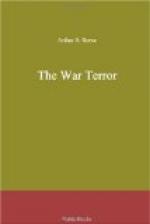It is one of the few substances which, in the present state of toxicology, might be criminally administered and leave no positive evidence of the crime. If a small but fatal dose of the poison were to be given, especially if it were administered hypodermically, the chances of its detection in the body after death would be practically none.
CHAPTER XI
The “Pillar of death”
I was looking at him fixedly as the diabolical nature of what must have happened sank into my mind. Here was a poison that defied detection. I could see by the look on Craig’s face that that problem, alone, was enough to absorb his attention. He seemed fully to realize that we had to deal with a criminal so clever that he might never be brought to justice.
An idea flashed over me.
“How about the letters?” I suggested.
“Good, Walter!” he exclaimed.
He untied the package which Mrs. Northrop had given him and glanced quickly over one after another of the letters.
“Ah!” he exclaimed, fairly devouring one dated at Mitla. “Listen— it tells about Northrop’s work and goes on:
“’I have been much interested in a cavern, or subterraneo, here, in the shape of a cross, each arm of which extends for some twelve feet underground. In the center it is guarded by a block of stone popularly called “the Pillar of Death.” There is a superstition that whoever embraces it will die before the sun goes down.
“’From the subterraneo is said to lead a long, underground passage across the court to another subterranean chamber which is full of Mixtec treasure. Treasure hunters have dug all around it, and it is said that two old Indians, only, know of the immense amount of buried gold and silver, but that they will not reveal it.’”
I started up. Here was the missing link which I had been waiting for.
“There, at least, is the motive,” I blurted out. “That is why Bernardo was so reticent. Northrop, in his innocence of heart, had showed him that inscription.”
Kennedy said nothing as he finally tied up the little packet of letters and locked it in his safe. He was not given to hasty generalizations; neither was he one who clung doggedly to a preconceived theory.
It was still early in the afternoon. Craig and I decided to drop into the museum again in order to see Doctor Bernardo. He was not there and we sat down to wait.
Just then the letter box in the door clicked. It was the postman on his rounds. Kennedy walked over and picked up the letter.
The postmark bore the words, “Mexico City,” and a date somewhat later than that on which Northrop had left Vera Cruz. In the lower corner, underscored, were the words, “Personal—Urgent.”
“I’d like to know what is in that,” remarked Craig, turning it over and over.
He appeared to be considering something, for he rose suddenly and shoved the letter into his pocket.




